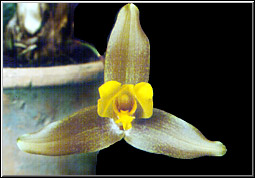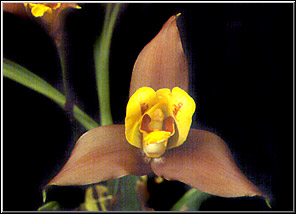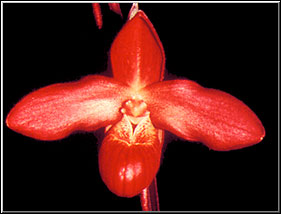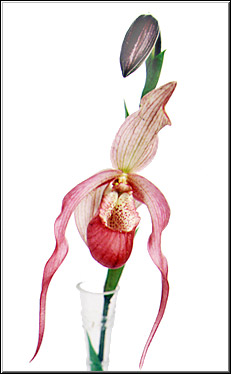WS: Zico, Jorge Verboonen, Exdras Porto... All those people. Exdras Porto and Jorge Verboonen were the last shareholders of S.B.O.
ON: How was to deal with all those skilled people? Rolf Altenburg, Zico...


| ON:
Who participated in the association when you got in? WS: Zico, Jorge Verboonen, Exdras Porto... All those people. Exdras Porto and Jorge Verboonen were the last shareholders of S.B.O. ON: How was to deal with all those skilled people? Rolf Altenburg, Zico... |
 |
| WS:
I met Rolf Altenburg for the first time when I was 18 years old, in Niterói, where I also used to live. I was a member of Gragoatá Regatta Club where I rowed. On Sunday, Rolf Altenburg and some other German people used to row there too. This is how we first met each other. Years later, when I became orchidophile I met him again. After I met Zico, his son-in-law, whose name was Siegwald Odebrecht, as it was very difficult to pronounce he became Zico. ON: What has been Rolf Altenburg's role in the development of the orchidophilia? WS: Rolf developed many hybrids, he also called an expert in cultivation from Hamburg, Germany, to do all his hybridizations. Besides, he associated to Binot nursery, but all those things are well know, OrquidaRio magazine has already published it. ON: I think his hybrid most known is BC. Pastoral, that was later used in more 70 new registered hybrids. He also did Cattleya Sonia Altenburg which was meristemed and is still very common in shows in Germany. Between 50 and 80 years, he did many hybrids although he did not register all... WS: I have the list of hybrids... look the quantity of hybrids they did. ON: According to this list, he did more than 2.000 hybrids. Here there are 2.008 but after the numbers are skipped. Why? WS: Because he gave another numbering for different genera such as Phalaenopsis, for example. ON: How was the orchidophilia scene in Rio de Janeiro, by this time? And when things started to be more structured? WS: When the Sociedade Fluminense (State of Rio de Janeiro association) started and later with S.B.O. in Niterói. Things went on developing... I already wrote an article published in Orquidário magazine where I approached the beginning, the development of the orchidophilia in Brabil (Orquidário magazine- Volume 10, nº 2, 1996, from April to June). When I started, the nurseries already existed and there was a big movement. But the movement in Brazil started before this. It is said that the first orchidophiles were the workers of brickyards in the suburbs of São Paulo, where is situated Pinheiros quarter nowadays. There were many brickyards there and they got firewood from inland and with them, the orchids, parasites (as they used to say), held on the trunks. As they found beautiful, pulled them out and put them in the trees or in the edges of roofs of their home. This is the beginning. However Luyz de Mendonça e Silva has been the great responsible for encouraging the movement, during the decades of 20 and 30. He found the Sociedade Fluminense de Orquidófilos, the first assocation in Niterói and in l938, he started to publish the magazine called "Orquídea". Later this association became the Sociedade Brasileira de Orquidófilos (Orchidophiles Brazilian Association), which head office was placed in Rio de Janeiro. This association had great names such as Guido Pabst, Rolf Altenburgh, Afrânio Silva Jardim, Jader Manso, Felisdoro Bastos Nunes and others. |
 |
ON:
How many nurseries existed by this time? WS: Practically there were Binot and Florália. There was another one in Petrópolis but it has been closed after. ON: How many cultivators, collectors? WS: It is hard to say, to calculate. In Em Petrópolis, for example, practicality every one has an orchid at home because the nurseries are very close. Once in a while, buys a pot, if it dies, buys another one. |
| ON: But, in general, the collections were bigger? How many they were? Were there more people cultivating than nowadays or we have more? |
| WS:
Nowadays there are more, by this time, just a few people cultivated orchids. Guilherme Guinle also had a nursery. He imported a lot from Europe but with his death, every thing has gone. ON: Did you meet each other to talk about orchids? WS: Non, I am talking about a time before I started. Before 1944. |
 |
| ON:
Do you know if those people met together to talk?
WS: No, everyone minds his own business. ON: So you had your orchids and the others had theirs and there was no contact between the cultivators? WS: This just started after the foundation of those associations. The orchidophiles started to attend the meetings that encouraged the contacts between them but before it there was nothing. ON: Neither informal? WS: Neither informal. ON: That means, you knew or you learnt about orchids by your own? WS: Yes, by myself. ON: And the cultivation, how was it? For example, people could have all species, genera or it was more restrict? WS: At the beginning, the cultivation was limited to local species, for us, for example, the species coming from the state of Rio de Janeiro. By this time, every one could go to the wood and took the plants. One pulled them out of their habitats and grew them at home. All thing were very primitive, in general, they were tied in a piece of wood, in a stub. ON: Moving forward the eighties years when you got in the association. What did the association do? Why you decided to get in? what was your motivation? WS: I was curious to learn. I went to a show and saw the people there, I thought that getting there I would get more knowledge, as I did, in fact, didn' t I? That was the way I got in. ON: Who participated in the association? WS: Álvaro Pessoa, Francisco Miranda, Roberto Agnes, Alex Sauer, with whom I had a very close friendship. He did a hybrid and registered it with my name, Lc. Waldemar Scheliga |
 |
ON:
What hybrid is this When he did it? WS: This is a cross of L. lobata X Lc. Canhamiana, registered in l993. |
| ON:
What has been the role of the association concerning raising up the orchidophile movement in Rio de Janeiro? Do you thing it is important to improve the spread of knowledge of orchidophilia? WS: For sure, it is important. Because of the show, the interest of the other people is aroused and many of them become orchidophiles. Unfortunately, not all because a part has a short lived enthusiasm. When this first enthusiasm has gone, they get tired and go away. However, some stay. So that the role of the association is exactly this, to diffuse the orchidophilia and it does it. After every show, we get almost 100 new subscriptions, new members. If half of them stay, it is already a big deal. OrquidaRIO has already had 1.000 members but nowadays, it is reduced to 600. We have just had a campaign to stimulate every associate to get a new one and thus, to reach 1.200 members. I did my part but I don't know if every body did. ON: Mr Waldemar Scheliga, although you have reduced your involvement with the cultivation, your intellectual production remains very intense, as it has been being for all those years. Besides to be one of the responsible for the foundation of OrchidaRio, to be vice-president and president of OrchidaRio Council, you have also been participating in the editorial committee of Orquidário magazine since l990, at least. It is rare to have an edition with out a translation or even article written by you. You really improve a great interchange of information through your translations. Often, we can read different works, originally published in German, translated by you. All those works done by Senghas, Rudolf Jenny, Irene Bock and other coming from Germany, are just accessible to us because of your translations. How does it happen? WS: When I see an interesting article, I ask for permission to publish it here. On the other hand, when I see here an interesting work such that of Kleber Lacerda (Orchid researcher, see Orchid News # 13), published in Caob Bulletin, I ask the responsible, Oscar Sachs (editor) in this case and translate to be published in Germany. In this way, I help people here to be diffused in Germany. The magazine "Die Orchidee" is printed in 8.000 copies and is sold, not only in Germany but also in Europe and United States. Campacci (orchid researcher, see Orchid News # 12), will send descriptions of new orchids to be published in Germany, in "Die Orchidee". They will be published in German and in English. I also translated Francisco Miranda's articles about Laelias, in three parts, besides articles wrote by Álvaro Pereira and Luiz Álvaro, father and son. I also write articles already published in OrquidaRIO magazine and also in "Mundo das Orquídea". (World of Orchids). Now, I am writing an article about Hoehne to be published in Germany. It is not well known but Hoehne has been named Doctor Honoris Causa, in the University of Göttingen. In this work, besides de photo I got at the Botanical Garden of São Paulo, the certificate will be also reproduced. The editors got a facsimile of the original and they will published it with the article. I have just done an article about Jorge Verboonen to be published in Germany, about his life and about Binot nursery that has been found more than 100 years ago and is considered the most old in the world. |
 |
ON:
Besides your editorial and cultivator activities, you has been the responsible
for the recuperation of the nursery of the Botanical Garden of Rio de Janeiro
and for the training of the staff, you have also distinguished with a certificate
as benefactor of that institution by the relevant works done to D. João
VI" House. How was this period? WS: It happened between l990 and l991. I coordinated the reorganization. By this time, I was vice-president of OrquidaRIO. We got many donations of plants and fittingss from the associates and from commercial nurseries. The collection has been also enriched by the work of botanists. In the end of l991, after being recuperated with the help, the support and technical assistance of OrquidaRIO, the nursery of the Botanical Garden has been re-inaugurated. ON: So you got there through OrquidaRIO? WS: OrquidaRIO needed to organize the nursery and Raimundo Mesquita, president of the association by this time, asked Miranda and me but he ducked out. |
| I
should struggle against many difficulties, there was no collaboration. ON: Are the constructions suitable? WS: It is too shaded. The roofing tiles are too old, yellowish. Nowadays, there are more modern tiles that come from São Paulo and are mat and easier to be cleaned. ON: Although wonderful, that glass greenhouse is very criticized because it is too hot. However, some plants grow very well there, such as Cattleya guttata, Cattleya amesthystoglossa, Cattleya loddigesii, Arachnis, Vanda tricolor, Renanthera, Bulbophyllum, Arundina, Oncidium baueri and some other. WS: This very old greenhouse, where it is still written "orchideario" (old word for "greenhouse" in Portuguese) is a cemetery to orchids. It is too hot. I proposed to put an exhaustion-electric fan to move the air inside. They know that because they put some kind of sprinkles over the roof but it is usefulness because it waters better inside than outside. |
|
ON:
In your opinion,
the genetic progress has been being positive, important? WS: Yes, because it was always question of new hybridations creating new plants. More wonderful and more interesting plants. |
 |